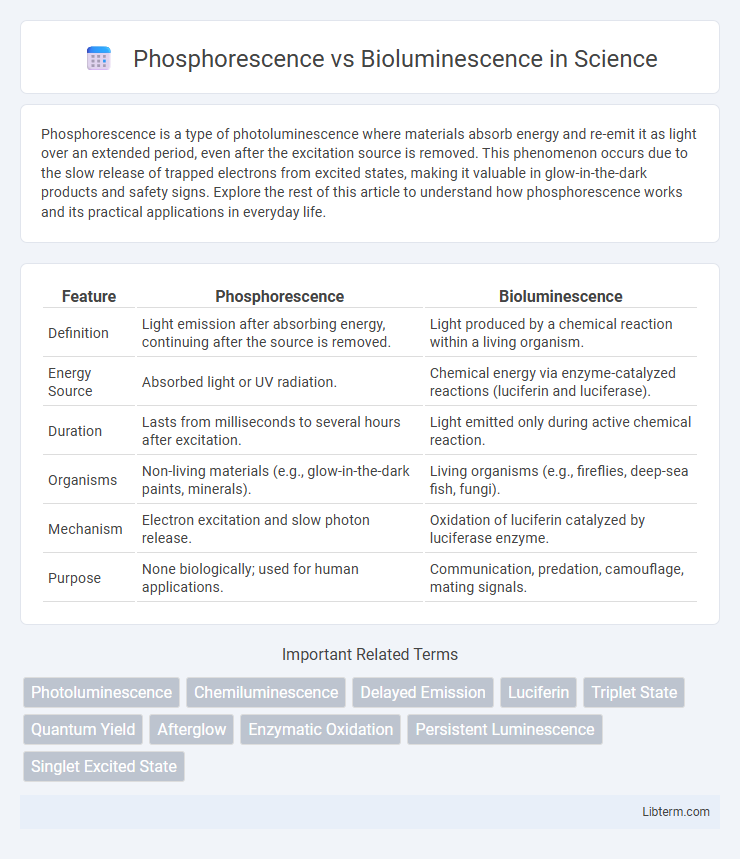Phosphorescence is a type of photoluminescence where materials absorb energy and re-emit it as light over an extended period, even after the excitation source is removed. This phenomenon occurs due to the slow release of trapped electrons from excited states, making it valuable in glow-in-the-dark products and safety signs. Explore the rest of this article to understand how phosphorescence works and its practical applications in everyday life.
Table of Comparison
| Feature | Phosphorescence | Bioluminescence |
|---|---|---|
| Definition | Light emission after absorbing energy, continuing after the source is removed. | Light produced by a chemical reaction within a living organism. |
| Energy Source | Absorbed light or UV radiation. | Chemical energy via enzyme-catalyzed reactions (luciferin and luciferase). |
| Duration | Lasts from milliseconds to several hours after excitation. | Light emitted only during active chemical reaction. |
| Organisms | Non-living materials (e.g., glow-in-the-dark paints, minerals). | Living organisms (e.g., fireflies, deep-sea fish, fungi). |
| Mechanism | Electron excitation and slow photon release. | Oxidation of luciferin catalyzed by luciferase enzyme. |
| Purpose | None biologically; used for human applications. | Communication, predation, camouflage, mating signals. |
Introduction to Phosphorescence and Bioluminescence
Phosphorescence is a type of photoluminescence where certain materials absorb energy and re-emit light over an extended period, even after the energy source is removed, commonly seen in glow-in-the-dark objects. Bioluminescence, in contrast, is the natural emission of light produced by living organisms through biochemical reactions, notably found in fireflies, deep-sea creatures, and some fungi. Both phenomena involve light emission, but phosphorescence relies on stored energy in materials, whereas bioluminescence results from enzymatic processes within organisms.
Defining Phosphorescence: Mechanisms and Characteristics
Phosphorescence is a photoluminescent phenomenon where certain materials absorb energy and re-emit light over an extended period after the excitation source is removed. This delayed emission occurs due to electron transitions from a triplet excited state to the singlet ground state, which is spin-forbidden, resulting in prolonged afterglow. Common phosphorescent materials include strontium aluminate and zinc sulfide, widely used in glow-in-the-dark applications and safety signage due to their sustained luminescence properties.
Understanding Bioluminescence: Nature’s Living Light
Bioluminescence is a biological process where living organisms produce and emit light through enzymatic reactions involving luciferin and luciferase. This natural light emission serves various ecological roles such as attracting mates, deterring predators, and facilitating communication in species like fireflies, deep-sea fish, and certain fungi. Unlike phosphorescence, which is a physical phenomenon caused by the absorption and slow release of energy in non-living materials, bioluminescence is a chemical reaction sustained by metabolic activity.
Key Differences Between Phosphorescence and Bioluminescence
Phosphorescence involves the absorption of light energy and its slow re-emission over time, resulting in a persistent glow after the light source is removed, commonly seen in glow-in-the-dark materials. Bioluminescence is a chemical reaction within living organisms like fireflies and deep-sea fishes, producing light through the enzymatic oxidation of luciferin. The key difference lies in phosphorescence being a physical process relying on external light excitation, while bioluminescence is a biological process generating light internally.
Chemical Processes Behind Phosphorescence
Phosphorescence involves the absorption of photons by a substance, exciting its electrons to a higher energy state, followed by a slow release of energy as visible light due to forbidden energy state transitions, leading to prolonged afterglow. This process occurs when excited electrons become trapped in metastable triplet states before returning to the ground singlet state, emitting photons over extended periods. Unlike bioluminescence, which is a biochemical reaction involving enzymes like luciferase, phosphorescence is a purely physical phenomenon based on electron spin and energy state transitions within inorganic or organic phosphors.
Biological Mechanisms of Bioluminescence
Bioluminescence in organisms results from a chemical reaction involving the enzyme luciferase acting on the substrate luciferin, producing light without heat. This biological mechanism contrasts with phosphorescence, which involves the absorption and slow re-emission of light energy by certain materials. Bioluminescent organisms, such as fireflies and deep-sea fish, utilize this enzymatic process for communication, predation, and camouflage in various environments.
Natural Examples of Phosphorescence and Bioluminescence
Natural examples of phosphorescence include minerals such as sphalerite and willemite that absorb sunlight and slowly re-emit light after dark. Bioluminescence occurs in marine organisms like the deep-sea anglerfish and plankton species such as dinoflagellates, which produce light through chemical reactions for communication, predation, or camouflage. Fungi like foxfire also exhibit bioluminescence, glowing in forest environments due to enzyme-driven light production.
Ecological Roles and Uses in Nature
Phosphorescence enables certain minerals and organisms to emit light after exposure to a light source, aiding in predator avoidance and camouflage during nighttime. Bioluminescence, produced by chemical reactions within living organisms like fireflies and deep-sea fish, serves crucial ecological roles such as attracting mates, deterring predators, and facilitating communication. Both processes enhance survival strategies in diverse environments, with bioluminescence playing a more dynamic role in biological signaling and ecosystem interactions.
Applications in Science and Technology
Phosphorescence finds critical applications in safety signage, watch dials, and forensic analysis due to its long-lasting afterglow properties, allowing visibility in low-light conditions without continuous energy input. Bioluminescence is extensively utilized in molecular biology and medical diagnostics, where enzymes like luciferase enable real-time imaging of cellular processes and detection of pathogens through light emission. Both phenomena advance environmental monitoring technologies, with phosphorescent materials used for pollutant detection and bioluminescent organisms serving as bioindicators of water quality.
Conclusion: Phosphorescence vs Bioluminescence Summary
Phosphorescence involves the absorption and slow release of light energy from non-living materials, creating a glow that persists after the light source is removed. Bioluminescence is a biochemical process where living organisms produce light through enzymatic reactions, primarily involving luciferase and luciferin. Both phenomena produce visible light but differ fundamentally in their origin, duration, and underlying mechanisms.
Phosphorescence Infographic

 libterm.com
libterm.com